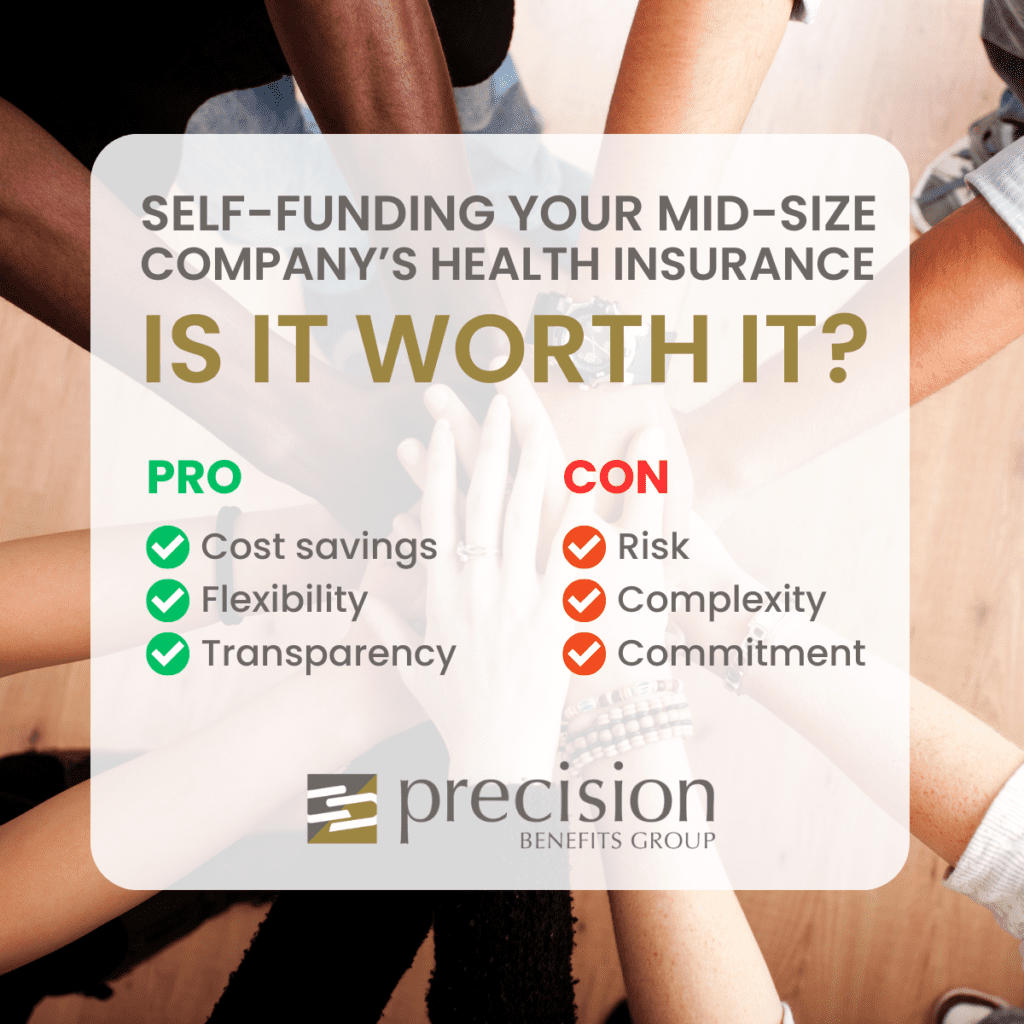
Health Insurance began during the Great Depression Era because hospitals and physicians needed a way to guarantee payment. However, private health insurance through employers grew rapidly from 1940 to 1960 due to several favorable laws. At the beginning of World War II only 7% of the United States population had health insurance. By 1960 that number had increased to 70%. Plans were at first community-rated and soon gave way to experience-rating (i.e., rates based on claims experience). The concept of retaining the insurance risk and self-funding the payment of claims soon became a way to manage costs. So, if the concept of self-insurance has been around for decades, why such a buzz about it lately?
To set the stage, let’s outline the main difference between being fully insured and being self-insured:
- Fully insured – Employer pays premiums to the insurance entity; in turn, the insurance entity manages and funds all medical claims for covered employees according to the parameters of the plan design.
- Self-Insured- Employer funds its own medical claims and hires a third party to manage all claims and hospital networks. It pays the third party a fee to do this; however, the company shoulders all the financial risk minus catastrophic claims which are covered by a stop loss insurance policy purchased by the employer.
By definition alone, it’s not hard to see that a higher degree of risk tolerance is required for those wanting to self-insure their health insurance (also referred to as a self-funded plan), combined with a little more work to understand the cost benefit. Entities whose management prefers the stability of consistent monthly expenses may not be well-suited to self-insuring their health insurance risk. An entity’s own funding of claims and claims activity may vary significantly from month to month. Another reason self-insuring may not be the right choice is if the ability to move is important. We recommend a 5-year commitment to a self-insured benefit strategy to help maximize the potential cost savings. The data driven executives that are willing to work with their consultant on plan design and pharmacy strategies and can sustain the ups and downs make the best fit for this strategy.
To help you decide, I interviewed Gregg Mills, FSA, MAAA, a healthcare actuary for BDO USA, P.C. and formerly of Independence Blue Cross for his perspective on some of the key decision factors:
Historically, self-funding was reserved for companies with 500 employees or more, but we see that number going down. What is the optimal size to consider self-funding?
- 500 is a good number, but it is not the most important factor when considering making the move from a fully insured to a self-insured healthcare plan. If your fully insured plan renewal rate increases have been generally favorable, it is likely that the economics of your plan are profitable regardless of how many people are employed. More importantly, when moving to a self-insured plan, the entity’s management must be willing to buy into the risk management strategy. Of course, they will need to actively engage and support their consultant in educating participating employees on how to be diligent consumers of healthcare (e.g., monitoring their data and working with employees to make cost effective choices). Management will need to articulate why taking a thoughtful approach to purchasing healthcare is not only good for the employer but good for employees as well. When both employees and employer are onboard from a philosophical standpoint, the chances of success increase.
You mention employees being “consumers of healthcare”. As you know, we recommend that a high deductible plan be paired with an HRA (Health Reimbursement Arrangement) or HSA (Health Savings Account) banking arrangement as a base option as soon as an entity is large enough to offer multiple medical plan options. How much impact do these types of plans have on overall claims experience?
- The key to better claims experience is to manage what you can control. With High Deductible Health Plans (HDHP), you will not be able to control everything; but HDHP plans are lower in cost and offer employees the opportunity to save by comparing cost for pharmaceuticals, advanced imaging scans, and a variety of other services. This financial incentive to shop around saves employees money, which in turn lowers overall costs and claims for all parties involved. As employees take on more of the financial burden in a high deductible plan, employers and employees are increasingly likely to take better ownership of their healthcare, driving lower claim costs. The higher the percentage of members migrating to these plans, the more this could translate to lower overall costs.
While an entity is most likely to save in the long run, most experts say that about once every 5 years an entity is going to experience a bad claims year with higher expenses. Do you agree?
- That could be the case, but either way, employers need to balance the volatility and be patient in riding it out.
Among the key advantages of self-funding are its flexibility and transparency. Employers can design plans; however, they would need to engage with their consultant to help use the vast amount of claims data to guide future benefit decisions. Do you feel this has a definitive impact on cost versus being fully insured?
- The detailed claims data is a plus for self-funding, but fully insured plans have much more plan design flexibility as of late. There is also an advantage to self-funded plans as it relates to federal mandates and Affordable Care Act fees. However, I suspect that more regulatory scrutiny is coming soon to self-funding.
Many self-funded solutions offer the ability to carve out pharmacy plans, sometimes using solutions out of Canada as well as other countries where the cost is significantly less. What do you think about that strategy?
- This could be a viable option for some organizations. One of the biggest advantages of self-funding is control of pharmacy; and pharmacy is one of the biggest drivers of overall cost.
What is your take on level funded plans that take the positive elements of self-funding with the guarantees of a fully insured product?
- This is a good way for employers to get a feel for self-funding with less reward, but also less risk.
I agree, at PBG we refer to the level-funded plans as self-funding on training wheels. Until you have claims data, it’s the best way to dip your toe into self-funding, especially if your company has approximately 50 employees or more. Many insurance carriers and TPAs offer these plans. You will only save about half of what you would have if you had gone with a riskier model, conversely, you still have the insurance companies’ backing if you run bad and you can get out easily without paying Run out claims. More importantly these plans provide a higher level of claims reporting which enables you to start collecting the important data needed to build a multiyear cost containment strategy with your benefit consultant. The data should also be used to tailor future wellness initiatives, which is something you should start spending more time thinking about when you reach 50 employees. The future of your company may or may not be a self-funded model, but at least you will not have to wonder if you could have done better the next time you get a large increase in premium upon renewal. If it does not work, you can always regroup and try again a few years later if you experienced growth or have a population shift. I feel these would be enough reasons to convince even the most risk-averse to give it a try.
Reference: History of health insurance

Rob is an employee benefits expert with over 25 years of experience. He is the founder and principal of Precision Benefits Group, a leading provider of corporate benefits plans. He is a member of the Philadelphia Business Journal Leadership Trust and regularly contributes to the publication.
